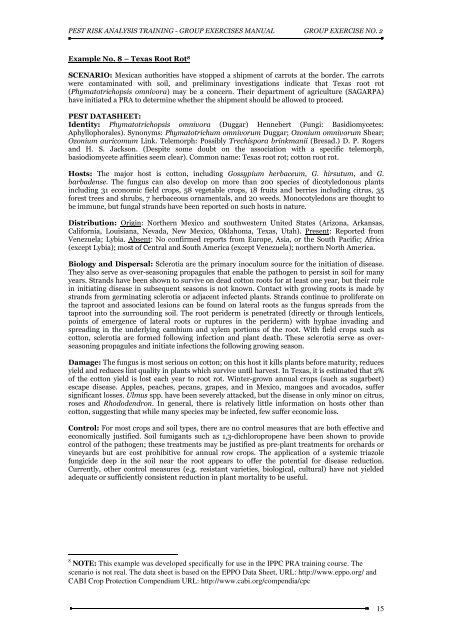PEST RISK ANALYSIS (PRA) TRAINING Group Exercises Manual
PEST RISK ANALYSIS (PRA) TRAINING Group Exercises Manual
PEST RISK ANALYSIS (PRA) TRAINING Group Exercises Manual
You also want an ePaper? Increase the reach of your titles
YUMPU automatically turns print PDFs into web optimized ePapers that Google loves.
<strong>PEST</strong> <strong>RISK</strong> <strong>ANALYSIS</strong> <strong>TRAINING</strong> - GROUP EXERCISES MANUAL GROUP EXERCISE NO. 2<br />
Example No. 8 – Texas Root Rot 8<br />
SCENARIO: Mexican authorities have stopped a shipment of carrots at the border. The carrots<br />
were contaminated with soil, and preliminary investigations indicate that Texas root rot<br />
(Phymatotrichopsis omnivora) may be a concern. Their department of agriculture (SAGARPA)<br />
have initiated a <strong>PRA</strong> to determine whether the shipment should be allowed to proceed.<br />
<strong>PEST</strong> DATASHEET:<br />
Identity: Phymatotrichopsis omnivora (Duggar) Hennebert (Fungi: Basidiomycetes:<br />
Aphyllophorales). Synonyms: Phymatotrichum omnivorum Duggar; Ozonium omnivorum Shear;<br />
Ozonium auricomum Link. Telemorph: Possibly Trechispora brinkmanii (Bresad.) D. P. Rogers<br />
and H. S. Jackson. (Despite some doubt on the association with a specific telemorph,<br />
basiodiomycete affinities seem clear). Common name: Texas root rot; cotton root rot.<br />
Hosts: The major host is cotton, including Gossypium herbaceum, G. hirsutum, and G.<br />
barbadense. The fungus can also develop on more than 200 species of dicotyledonous plants<br />
including 31 economic field crops, 58 vegetable crops, 18 fruits and berries including citrus, 35<br />
forest trees and shrubs, 7 herbaceous ornamentals, and 20 weeds. Monocotyledons are thought to<br />
be immune, but fungal strands have been reported on such hosts in nature.<br />
Distribution: Origin: Northern Mexico and southwestern United States (Arizona, Arkansas,<br />
California, Louisiana, Nevada, New Mexico, Oklahoma, Texas, Utah). Present: Reported from<br />
Venezuela; Lybia. Absent: No confirmed reports from Europe, Asia, or the South Pacific; Africa<br />
(except Lybia); most of Central and South America (except Venezuela); northern North America.<br />
Biology and Dispersal: Sclerotia are the primary inoculum source for the initiation of disease.<br />
They also serve as over-seasoning propagules that enable the pathogen to persist in soil for many<br />
years. Strands have been shown to survive on dead cotton roots for at least one year, but their role<br />
in initiating disease in subsequent seasons is not known. Contact with growing roots is made by<br />
strands from germinating sclerotia or adjacent infected plants. Strands continue to proliferate on<br />
the taproot and associated lesions can be found on lateral roots as the fungus spreads from the<br />
taproot into the surrounding soil. The root periderm is penetrated (directly or through lenticels,<br />
points of emergence of lateral roots or ruptures in the periderm) with hyphae invading and<br />
spreading in the underlying cambium and xylem portions of the root. With field crops such as<br />
cotton, sclerotia are formed following infection and plant death. These sclerotia serve as overseasoning<br />
propagules and initiate infections the following growing season.<br />
Damage: The fungus is most serious on cotton; on this host it kills plants before maturity, reduces<br />
yield and reduces lint quality in plants which survive until harvest. In Texas, it is estimated that 2%<br />
of the cotton yield is lost each year to root rot. Winter-grown annual crops (such as sugarbeet)<br />
escape disease. Apples, peaches, pecans, grapes, and in Mexico, mangoes and avocados, suffer<br />
significant losses. Ulmus spp. have been severely attacked, but the disease in only minor on citrus,<br />
roses and Rhododendron. In general, there is relatively little information on hosts other than<br />
cotton, suggesting that while many species may be infected, few suffer economic loss.<br />
Control: For most crops and soil types, there are no control measures that are both effective and<br />
economically justified. Soil fumigants such as 1,3-dichloropropene have been shown to provide<br />
control of the pathogen; these treatments may be justified as pre-plant treatments for orchards or<br />
vineyards but are cost prohibitive for annual row crops. The application of a systemic triazole<br />
fungicide deep in the soil near the root appears to offer the potential for disease reduction.<br />
Currently, other control measures (e.g. resistant varieties, biological, cultural) have not yielded<br />
adequate or sufficiently consistent reduction in plant mortality to be useful.<br />
8 NOTE: This example was developed specifically for use in the IPPC <strong>PRA</strong> training course. The<br />
scenario is not real. The data sheet is based on the EPPO Data Sheet, URL: http://www.eppo.org/ and<br />
CABI Crop Protection Compendium URL: http://www.cabi.org/compendia/cpc<br />
15













